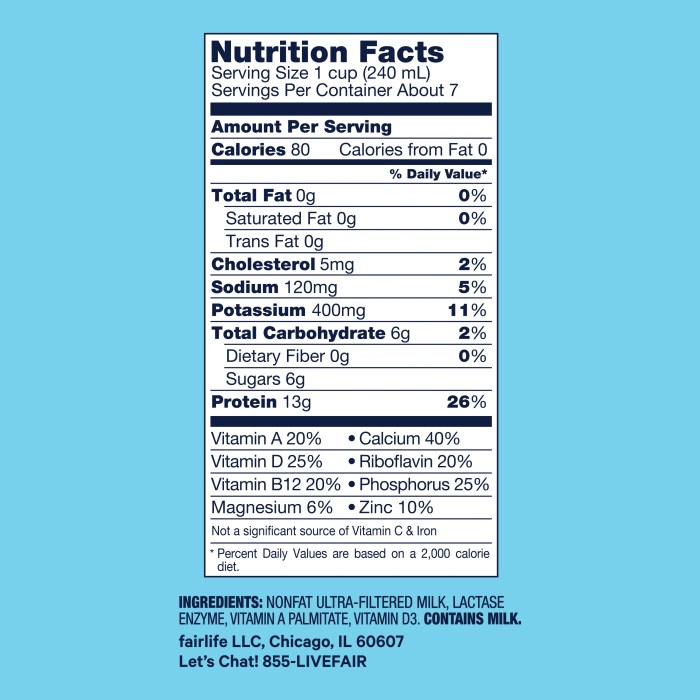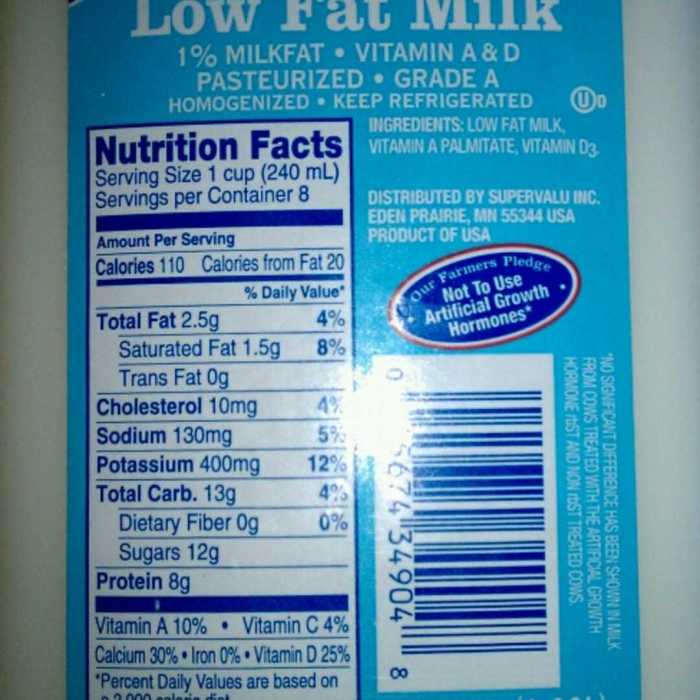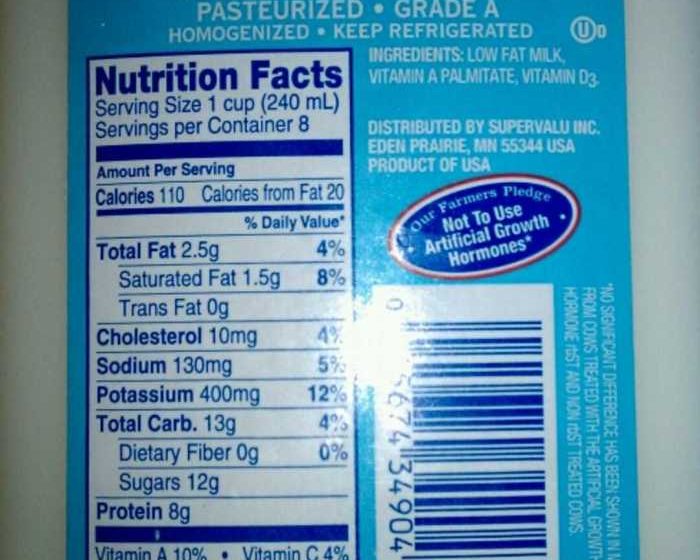Nutritional Composition of Skim Milk

Skim milk nutrition facts – Skim milk, also known as nonfat milk, offers a valuable source of nutrients while being lower in fat compared to other milk types. Understanding its nutritional profile allows for informed dietary choices. This section details the macronutrient and micronutrient composition of skim milk, highlighting its differences from whole and 2% milk.
Macronutrient Breakdown in Skim Milk
A typical serving of skim milk (approximately one cup or 240ml) provides a significant amount of protein and carbohydrates, with minimal fat. The precise values may vary slightly depending on the brand and processing methods. Generally, expect to find approximately 8 grams of protein, less than 0.5 grams of fat, and around 12 grams of carbohydrates per serving.
This macronutrient profile makes skim milk a suitable choice for individuals seeking a protein boost with lower fat intake.
Micronutrient Content of Skim Milk
Skim milk is a good source of several essential vitamins and minerals. A single serving typically contains a substantial amount of calcium, crucial for bone health, and riboflavin (vitamin B2), important for energy metabolism. It also provides smaller but still significant quantities of other vitamins like vitamin A, vitamin D, and vitamin B12, along with minerals such as phosphorus and potassium.
The specific amounts can vary based on fortification practices; many brands fortify skim milk to ensure adequate levels of certain vitamins and minerals.
Comparison of Nutritional Content Across Different Milk Types, Skim milk nutrition facts
The table below compares the nutritional composition of skim milk to whole milk and 2% milk, illustrating the differences in fat, protein, and carbohydrate content per serving (approximately one cup or 240ml). Note that values are approximate and may vary slightly depending on the brand.
| Nutrient | Skim Milk | 2% Milk | Whole Milk |
|---|---|---|---|
| Fat (grams) | <0.5 | ~5 | ~8 |
| Protein (grams) | ~8 | ~8 | ~8 |
| Carbohydrates (grams) | ~12 | ~12 | ~12 |
| Calories | ~80-90 | ~120-130 | ~150-160 |
Potential Drawbacks of Skim Milk
While skim milk offers significant health benefits due to its lower fat content, it’s important to acknowledge potential drawbacks. Removing the fat from milk also removes some beneficial nutrients, and excessive consumption can have unintended consequences. Understanding these aspects allows for a more balanced approach to incorporating skim milk into a healthy diet.
One primary concern is the potential for nutrient deficiencies. The fat in whole milk contains fat-soluble vitamins like Vitamins A, D, E, and K, as well as essential fatty acids. Skim milk, by its very nature, is significantly lower in these nutrients. Individuals relying heavily on skim milk as their primary source of calcium and other nutrients might experience deficiencies if their overall diet doesn’t compensate for these losses.
For example, a person consuming only skim milk and neglecting other sources of Vitamin D might develop a deficiency leading to weakened bones and increased risk of fractures.
Skim milk, a popular choice for its lower fat content, offers a good source of protein and calcium. However, comparing its nutritional profile to other foods is important for balanced eating. For instance, consider the significant difference in caloric and fat content when comparing skim milk to, say, the costco pizza nutrition facts , which highlights the importance of mindful portion control.
Returning to skim milk, remember that its nutritional value depends on factors like fortification and brand.
Nutrient Deficiencies in Skim Milk
The removal of fat from milk results in a reduction of fat-soluble vitamins (A, D, E, and K) and essential fatty acids. While fortified skim milk often adds some vitamins back, the levels might not always match those found in whole milk. Consequently, individuals who consume large quantities of skim milk without a balanced diet may experience deficiencies in these crucial nutrients.
This can manifest in various health problems depending on the specific vitamin or fatty acid lacking. For instance, a Vitamin D deficiency can lead to rickets in children or osteomalacia in adults, characterized by soft and weakened bones.
Impact of Excessive Skim Milk Consumption
While skim milk is a good source of calcium and protein, excessive consumption can have negative impacts. The high lactose content can cause digestive issues like bloating, gas, and diarrhea in individuals with lactose intolerance. Furthermore, consuming excessive amounts of any single food, even a healthy one like skim milk, can displace other nutrient-rich foods from the diet, potentially leading to an unbalanced nutritional intake.
For instance, someone prioritizing skim milk over fruits and vegetables may suffer from a lack of fiber and essential micronutrients.
Environmental Impact of Skim Milk Production
The environmental impact of skim milk production is largely similar to that of whole milk production, with the main difference being the slightly lower energy required for processing due to the reduced fat content. However, both whole and skim milk production share common environmental concerns, including greenhouse gas emissions from livestock, water usage for feed production and cleaning, and land use for grazing and feed crops.
Compared to plant-based milk alternatives, dairy milk production generally has a higher environmental footprint due to the greater resource intensity of animal agriculture. For example, almond milk production requires significant water resources, while soy milk production can contribute to deforestation if not sourced sustainably. The most environmentally friendly choice will vary depending on local production practices and the specific plant-based alternative considered.
Skim Milk and Specific Dietary Needs

Skim milk’s suitability varies depending on individual dietary needs and health conditions. Understanding its nutritional profile in relation to specific restrictions and health goals is crucial for informed consumption. This section explores how skim milk integrates into various dietary plans and its potential role in managing certain health concerns.
Skim Milk and Dietary Restrictions
Skim milk, due to its low fat content, presents certain advantages and disadvantages across various dietary restrictions. For individuals with lactose intolerance, the lactose content remains a primary concern. While some may tolerate small quantities, others might experience digestive discomfort. Lactose-free skim milk is readily available as an alternative, offering the nutritional benefits of skim milk without the lactose.
For vegans, skim milk is unsuitable as it is a dairy product. Plant-based milk alternatives, such as soy milk, almond milk, or oat milk, provide comparable nutritional profiles (often fortified) but lack the naturally occurring nutrients found in dairy.
Skim Milk and Diets for Specific Health Conditions
Skim milk can play a role in managing certain health conditions, although individual needs vary greatly and professional advice is essential. For individuals managing high blood pressure, skim milk’s lower fat content compared to whole milk can contribute to a heart-healthy diet. Reduced fat intake can aid in blood pressure management, but it’s crucial to consider sodium content in the overall diet.
For weight management, skim milk can be a beneficial component. Its lower calorie count compared to whole milk, coupled with its protein content, can contribute to satiety and help regulate appetite. However, it is important to note that overall calorie intake and dietary habits remain the primary factors in weight loss or maintenance.
Nutritional Comparison: Skim Milk vs. Fortified Skim Milk
Imagine a bar graph comparing the nutritional content of regular skim milk and a fortified version. Both would show similar levels of protein, but the fortified version would have significantly higher levels of Vitamin D and potentially Vitamin A, Calcium, and other added nutrients. Regular skim milk might show a small amount of naturally occurring vitamins and minerals, but the fortified version would display a much more substantial increase in these essential nutrients, visually represented by taller bars on the graph.
This clearly demonstrates the benefit of fortification for those seeking enhanced nutritional value.
Commonly Asked Questions: Skim Milk Nutrition Facts
Is skim milk good for weight loss?
Skim milk’s low-fat content can contribute to weight management, as it provides satiety without excessive calories. However, it’s crucial to consider overall calorie intake and dietary habits for effective weight loss.
Does skim milk cause bloating?
Some individuals experience bloating after consuming dairy products due to lactose intolerance. Lactose-free skim milk options are available for those sensitive to lactose.
Can children drink skim milk?
While skim milk is lower in fat, children still require fat for healthy growth and development. Whole milk or 2% milk is generally recommended for children, unless advised otherwise by a pediatrician.
Is skim milk better than almond milk?
This depends on individual needs. Skim milk is higher in protein and calcium, while almond milk is lower in calories and fat, and often fortified with vitamins and minerals. The best choice depends on your dietary goals and preferences.

